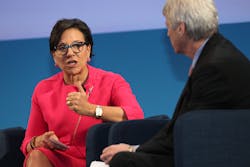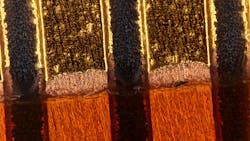White House Officials to Start Thinking Harder about Hardware
The White House wants to give a booster shot to the semiconductor industry, but it needs some help.
The Office of Science and Technology Policy announced last week that it had formed an advisory board for semiconductors, one that would urge policies to protect American leadership in the microscopic slabs of silicon.
The Semiconductor Working Group, as it is called, is one of the first attempts in decades to reinforce an industry that has quietly embedded itself into every aspect of modern life. Semiconductors are the tiny electronics heart of everything from fighter jets and autonomous cars to smartphones and corporate servers.
In the view of business executives and government regulators, the technology is vital to the United States economy and national security. In 2014, sales of American chips accounted for over half the entire semiconductor market. The industry is responsible for the third largest American manufactured export, behind aircraft and automobiles.
But over the last two years, American chipmakers have strained under increasing competition from China and the inflexibility of physics, which is making it harder to further shrink computer circuits. In addition, the largest companies are buying each other at breakneck speed, betting billions in stockpiled cash that new combinations of chips can restart growth.
John Holdren, the director of the Office of Science and Technology Policy, said that the task force will “identify the core challenges facing the semiconductor industry at home and abroad and identify major opportunities for sustaining U.S. leadership.” In a statement, Holdren added that he will serve as co-chairman of the board.
Paul Otellini, the former chief executive of Intel, will serve as the other co-chairman. The other 10 board members include former executives at chipmakers like Applied Materials, Global Foundries, and Northrop Grumman. They will release a report on the state of the industry early next year, according to White House officials.
The new board invites comparison to earlier ventures, such as the National Advisory Committee on Semiconductors, created in 1988 to guide the industry’s revitalization after falling behind Japan. It proposed weaker antitrust laws, tax incentives for new factories, and increased funding for Sematech, a research laboratory where Intel and other chipmakers sent engineers to plot new generations of chips.
The committee only lasted three years, but it was part of an aggressive strategy that helped resuscitate the American chip industry by 1994. For the last two decades, the U.S. has dominated the technology and sales sides of the business. In recent years, new threats have cropped up and government-sponsored research efforts like Sematech faded.
The circuits etched onto the surface of silicon wafers are verging on the size of individual atoms. That is bad news for Moore’s Law, an idea proposed by Intel founder Gordon Moore that the number of transistors that can be squeezed onto chips doubles every two and a half years. It is also not clear that the cost benefits of making smaller transistors is worth it.
“The growing cost of designing and fabricating higher-performance chips in the conventional mold is already stifling innovation, making it more difficult for startups and new ideas from university research to create new markets,” Holdren said.
The advisory board plans to identify the most promising ways to extend Moore’s Law. The options could include new chip architectures, optical computing, or specialized hardware like the accelerators that Google created to power machine learning algorithms in its servers.
Their report could also advise policy makers on countering China’s chip-making ambitions. The country has been trying to remain one of the largest markets for chips without also being its largest importer. In 2013, China spent $232 billion on foreign chips, topping its petroleum bill.
To break its habit, Beijing has poured vast amounts of money into Chinese chipmakers. The government has reserved an estimated $170 billion to spend on building its chip industry. But that massive investment has the potential to hurt American companies.
“Such policies could lead to overcapacity and dumping, reduce incentives for private-sector R&D in the United States, and thereby slow the pace of semiconductor innovation,” said Holdren, who never explicitly named China in a statement.
Penny Pritzker, the U.S. secretary of commerce, called out China in a Wednesday speech on semiconductors. She sharply criticized the country for pouring billions of dollars into the market, using subsidies to artificially reduce prices, and cutting into the profits – and research budgets – of American rivals.
“This unprecedented state-driven interference can distort the market and undermine the innovation ecosystem,” she said in her speech at the Center for Strategic and International Studies.
She also condemned China’s practice of trading market access for intellectual property. Qualcomm, for example, has signed deals to create advanced technology with Semiconductor Manufacturing International Corporation, while also throwing it some chip orders. Intel has invested over a billion dollars into Tsinghua Unigroup, a state-controlled chipmaker that has turned into a national darling.
For now, it is unclear the extent to which the advisory board will shape policy and semiconductor technology. It had been created late in President Barack Obama’s final term, so it might not survive long after he leaves office in January.
While the announcement was short on specifics, industry watchers praised the White House for shining a light on semiconductors. Robert Atkinson, president of the Information Technology and Innovation Foundation, lauded the advisory board on Twitter for tackling “unfair” Chinese policies.
John Neuffer, chief executive of the Semiconductor Industry Association, whose members include Intel and Qualcomm, described the group as long overdue. “Maintaining U.S. technological leadership requires a healthy and vibrant U.S. semiconductor industry, which continues to invest heavily in its own future,” he said in a statement.
About the Author
James Morra
Senior Editor
James Morra is the senior editor for Electronic Design, covering the semiconductor industry and new technology trends, with a focus on power electronics and power management. He also reports on the business behind electrical engineering, including the electronics supply chain. He joined Electronic Design in 2015 and is based in Chicago, Illinois.




